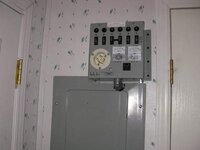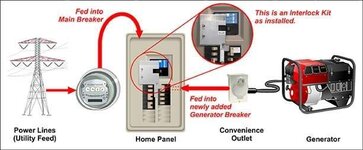Bronze Supporter
- Messages
- 8,269
- Reactions
- 18,033
I posted this on an aviation forum after someone asked for input. I'm reposting here in case any of you have ever considered a generator for your home. Please ask if any additional questions.
Peter
So the three big things you'll need:
- generator
- generator-transformer box (aka gentran)
- thick 220v cable from generator to gentran
- certified electrician to install the gentran, and make you a cable
I was into mine for say $1500 back in 1997. You could probably get into same for $2000-$2500 today with an install by a certified electrician.
If you choke on the price, ask yourself what it might cost to replace the food each time in the fridge and freezer. Add to that any costs if you went to a hotel, and then of course the intangible value of simply continuing most of your current way of life without too much interruption.
First, what can you power?
- Yes to a gas furnace. You're just running the blower and the temp sensor. Probably no on an electric furnace.
- Probably no to an electric hot-water tank (if gas, no electricity required)
- Yes to a microwave
- Yes to a 120v fridge
- Yes to a 120v freezer
- Yes to TV, computers, lights
- No to an electric oven or cooktop.
- No to an electric dryer
- Probably yes to a sump pump (if you have one, and if it's 120v)
You'll need to assess what can be powered by the generator. There are limits. You can't have everything running at once since the generator will have a finite output of electricity. For example, the microwave call pull up to 1000 watts for a large, hi-power model. The good news is that everything doesn't run at once, but I do try to keep the total load down on my generator so as not to damage it.
Generator. Many options. You can probably get a good one at Costco for $800. Two key considerations are total continuous watts available, and then do you go with manual/pull start or electric start. Mine is 5000 watts continuous and 6250 surge/temporary watts. I would recommend at least 5000 watts for a typical home. My generator is also a pull start. The pull start on a 10hp engine is fine for me but difficult for my wife. A generator with an engine larger than 10hp may be harder to pull start.
Gentran. This controllers what circuits get powered by the generator, and keeps the electricity within your house. Buy a unit/panel with at least 10 switches. 1 switch = 1 circuit breaker in your house. Also, you might get one with a watt meter for each side of switches since this gives you an indication of how many watts you're pulling at that point in time. Each Gentran switch tends to have 3 positions: Line (typical power), Off, and Gen (your generator). So in real use you flip the individual switch from Line to Gen and *tada* that circuit is now getting juice from the generator. It's that easy. It's also safe since your generator is not providing power back out on the line, energizing the transformer, and potentially jolting/killing a lineman upstream from you.
Wiring in the Gentran. Work with the electrician to determine what circuits you want to connect to the Gentran (you might even pre-identify and mark the circuit breakers if you're paying the electrician by the hour). The electrician can take it from there.
Cable. The electrician can make you an appropriate cable with 220v connectors on each end. Ensure that the cable is long enough so that the generator is not running right next to your house. Mine is 50 feet long and I think it cost me $5/ft at the time (it is almost 3/4" thick). I keep my generator in the garage to reduce exposure to the elements when it is idle, but when it's running I've had it out un-sheltered in the wind/rain/snow and never had a problem.
Maintenance on the generator. This is critical. Don't let it sit for a year or two and assume it will magically start. I pull my generator out 3-4x a year and run it for 20min. I also change the oil every Fall regardless. If you have an electric starter then you'll want to keep an eye on the battery on the generator. I've had the same $500 generator since 1997 and it's never failed us. Most outages have been a few hours, but in 2006 there was a bad windstorm and we were on the generator for perhaps 30 hours. I also tend to run the generator for 20min in advance of a large storm.
Spare fuel. Every generator is different. Mine burns approx 5 gallons of gas every 8-10 hours. I try to keep about 20 gallons of fuel in the shed, and use/replenish via the generator, lawn tractor, etc. such that the fuel isn't too old.
Suggestion. Buy the generator at Costco (or other), and then perhaps the Gentran at Home Depot if they're still offering a referral service to certified electricians.
Peter
So the three big things you'll need:
- generator
- generator-transformer box (aka gentran)
- thick 220v cable from generator to gentran
- certified electrician to install the gentran, and make you a cable
I was into mine for say $1500 back in 1997. You could probably get into same for $2000-$2500 today with an install by a certified electrician.
If you choke on the price, ask yourself what it might cost to replace the food each time in the fridge and freezer. Add to that any costs if you went to a hotel, and then of course the intangible value of simply continuing most of your current way of life without too much interruption.
First, what can you power?
- Yes to a gas furnace. You're just running the blower and the temp sensor. Probably no on an electric furnace.
- Probably no to an electric hot-water tank (if gas, no electricity required)
- Yes to a microwave
- Yes to a 120v fridge
- Yes to a 120v freezer
- Yes to TV, computers, lights
- No to an electric oven or cooktop.
- No to an electric dryer
- Probably yes to a sump pump (if you have one, and if it's 120v)
You'll need to assess what can be powered by the generator. There are limits. You can't have everything running at once since the generator will have a finite output of electricity. For example, the microwave call pull up to 1000 watts for a large, hi-power model. The good news is that everything doesn't run at once, but I do try to keep the total load down on my generator so as not to damage it.
Generator. Many options. You can probably get a good one at Costco for $800. Two key considerations are total continuous watts available, and then do you go with manual/pull start or electric start. Mine is 5000 watts continuous and 6250 surge/temporary watts. I would recommend at least 5000 watts for a typical home. My generator is also a pull start. The pull start on a 10hp engine is fine for me but difficult for my wife. A generator with an engine larger than 10hp may be harder to pull start.
Gentran. This controllers what circuits get powered by the generator, and keeps the electricity within your house. Buy a unit/panel with at least 10 switches. 1 switch = 1 circuit breaker in your house. Also, you might get one with a watt meter for each side of switches since this gives you an indication of how many watts you're pulling at that point in time. Each Gentran switch tends to have 3 positions: Line (typical power), Off, and Gen (your generator). So in real use you flip the individual switch from Line to Gen and *tada* that circuit is now getting juice from the generator. It's that easy. It's also safe since your generator is not providing power back out on the line, energizing the transformer, and potentially jolting/killing a lineman upstream from you.
Wiring in the Gentran. Work with the electrician to determine what circuits you want to connect to the Gentran (you might even pre-identify and mark the circuit breakers if you're paying the electrician by the hour). The electrician can take it from there.
Cable. The electrician can make you an appropriate cable with 220v connectors on each end. Ensure that the cable is long enough so that the generator is not running right next to your house. Mine is 50 feet long and I think it cost me $5/ft at the time (it is almost 3/4" thick). I keep my generator in the garage to reduce exposure to the elements when it is idle, but when it's running I've had it out un-sheltered in the wind/rain/snow and never had a problem.
Maintenance on the generator. This is critical. Don't let it sit for a year or two and assume it will magically start. I pull my generator out 3-4x a year and run it for 20min. I also change the oil every Fall regardless. If you have an electric starter then you'll want to keep an eye on the battery on the generator. I've had the same $500 generator since 1997 and it's never failed us. Most outages have been a few hours, but in 2006 there was a bad windstorm and we were on the generator for perhaps 30 hours. I also tend to run the generator for 20min in advance of a large storm.
Spare fuel. Every generator is different. Mine burns approx 5 gallons of gas every 8-10 hours. I try to keep about 20 gallons of fuel in the shed, and use/replenish via the generator, lawn tractor, etc. such that the fuel isn't too old.
Suggestion. Buy the generator at Costco (or other), and then perhaps the Gentran at Home Depot if they're still offering a referral service to certified electricians.













